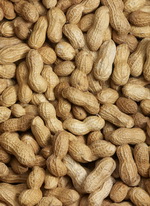
Genome Sequence of Cultivated Groundnut Completed
March 2, 2016| |
 The International Peanut Genome Initiative (IPGI), including researchers from the University of Georgia and the International Crops Research Institute for the Semi-Arid Tropics (ICRISAT), has completed sequencing the ancestral genomes of groundnut.
The International Peanut Genome Initiative (IPGI), including researchers from the University of Georgia and the International Crops Research Institute for the Semi-Arid Tropics (ICRISAT), has completed sequencing the ancestral genomes of groundnut.
The groundnut that is grown today comes from the hybridization of two wild species, Arachis duranensis (V14167, A-genome ancestor) and A. ipaensis (K30076, B-genome ancestor), cultivated in South America. To map the groundnut's genome structure, the researchers sequenced the two ancestral parents, and the sequences provide researchers access to 96% of all groundnut genes in their genomic context. A comparison of the DNA sequences of one of the wild species with the cultivated groundnut showed that they are 99.96% identical.
"Improving groundnut varieties to be more drought, insect and disease resistant using the genome sequence, can help farmers in developing nations produce more groundnuts with fewer pesticides and other chemicals and help these farmers feed their families and build more secure livelihoods," said Dr. Rajeev Varshney, Research Program Director – Grain Legumes and Director, Center of Excellence in Genomics at ICRISAT.
For more details, read the news release at the ICRISAT website.
| |
Biotech Updates is a weekly newsletter of ISAAA, a not-for-profit organization. It is distributed for free to over 22,000 subscribers worldwide to inform them about the key developments in biosciences, especially in biotechnology. Your support will help us in our mission to feed the world with knowledge. You can help by donating as little as $10.
-
See more articles:
-
News from Around the World
- International Team Decodes Mesoamerican Bean Genome
- Researchers Find Molecular Marker for Calcium in Potatoes
- New Study Reveals Eliminating GMOs would Take Toll on Environment, Economies
- Study Shows Plants Forget Unused Memories
- Filipino Farmer Leaders Learn from Bt Brinjal Farmers in Bangladesh
- Genome Sequence of Cultivated Groundnut Completed
- Wageningen UR Develops Method for Selecting Plants with Better Photosynthesis
-
Research Highlights
- Overexpression of PslTIR1 in Tomato alters Fruit Shelf-life Characteristics
- Mutated Garlic Gene Expressed in Rice Confers Resistance to Sheath Blight
- Expression of Tomato Prosystemin in Tobacco Enhances Plant Resistance to Botrytis cinerea
-
Beyond Crop Biotech
- Bacteria Take "Mug Shots" of Threatening Viruses
- University of Missouri Scientists Breed PRRS Resistant Pigs using CRISPR
-
From the BICs
- UBIC Holds Meeting for Biotech Communication Stakeholders
-
Announcements
- 5th International Conference and Exhibition on Metabolomics
- 3rd Plant Genomics Congress: Asia
-
Read the latest: - Biotech Updates (November 12, 2025)
- Gene Editing Supplement (October 29, 2025)
- Gene Drive Supplement (February 22, 2023)
-
Subscribe to BU: - Share
- Tweet
